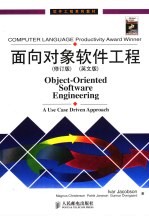

面向对象软件工程 英文版PDF电子书下载
- 电子书积分:16 积分如何计算积分?
- 作 者:雅各布森(Jacobson
- 出 版 社:北京:人民邮电出版社
- 出版年份:2003
- ISBN:7115111634
- 页数:538 页
Part Ⅰ Introduction 1
1 System development as an industrial process 1
1.1 Introduction 1
1.2 A useful analogy 2
1.3 System development characteristics 8
1.4 Summary 19
2 The system life cycle 21
2.1 Introduction 21
2.2 System development as a process of change 21
2.3 System development and reuse 26
2.4 System development and methodology 29
2.5 Objectory 38
2.6 Summary 40
3.1 Introduction 42
3 What is object-orientation? 42
3.2 Object 44
3.3 Class and instance 49
3.4 Polymorphism 55
3.5 Inheritance 56
3.6 Summary 68
4 Object-oriented system development 69
4.1 Introduction 69
4.2 Function/data methods 73
4.3 Object-oriented analysis 76
4.4 Object-oriented construction 79
4.5 Object-oriented testing 80
4.6 Summary 83
5 Object-oriented programming 84
5.1 Introduction 84
5.2 Objects 86
5.3 Classes and instances 87
5.4 Inheritance 93
5.5 Polymorphism 99
5.6 An example 102
5.7 Summary 105
Part Ⅱ Concepts 107
6 Architecture 107
6.1 Introduction 109
6.2 System development is model building 113
6.3 Model architecture 125
6.4 Requirements model 126
6.5 Analysis model 130
6.6 The design model 143
6.7 The implementation model 149
6.8 Test model 150
6.9 Summary 151
7 Analysis 153
7.1 Introduction 153
7.2 The requirements model 156
7.3 The analysis model 174
7.4 Summary 199
8 Construction 201
8.1 Introduction 201
8.2 The design model 204
8.3 Blockdesign 229
8.4 Working with construction 251
8.5 Summary 256
9 Real-time specialization 258
9.1 Introduction 258
9.2 Classification of real-time systems 259
9.3 Fundamental issues 260
9.4 Analysis 261
9.5 Construction 263
9.6 Testing and verification 272
9.7 Summary 273
10 Database specialization 274
10.1 Introduction 274
10.2 Relational DBMS 276
10.3 Object DBMS 285
10.4 Discussion 287
10.5 Summary 288
11 Components 289
11.1 Introduction 289
11.2 What is a component? 294
11.3 Use of components 297
11.4 Component management 301
11.5 Summary 311
12.1 Introduction 313
12 Testing 313
12.2 On testing 315
12.3 Unit testing 323
12.4 Integration testing 330
12.5 System testing 333
12.6 The testing process 333
12.7 Summary 338
Part Ⅲ Applications 341
13 Case study:warehouse management system 343
13.1 Introduction to the examples 343
13.2 ACME Warehouse Management Inc. 343
13.3 The requirements model 345
13.4 The analysis model 356
13.5 Construction 376
14.2 Telecommunication switching systems 393
14 Case study:telecom 393
14.1 Introduction 393
14.3 The requirements model 397
14.4 The analysis model 407
14.5 The design model 416
14.6 The implementation model 428
15 Managing object-oriented software engineering 436
15.1 Introduction 436
15.2 Project selection and preparation 436
15.3 Product development organization 445
15.4 Project organization and management 450
15.5 Project staffing 459
15.6 Software quality assurance 463
15.7 Software metrics 468
15.8 Summaryc 472
16.1 Introduction 474
16 Other object-oriented methods 474
16.2 A summary of object-oriented methods 476
16.3 Object-Oriented Analysis(OOA/Coad-Yourdon) 479
16.4 Object-Oriented Design(OOD/Booch) 484
16.5 Hierarchical Object-Oriented Design(HOOD) 487
16.6 Object Modeling Technique(OMT) 493
16.7 Responsibility-Driven Design 496
16.8 Summary 500
Appendix A On the development of Objectory 503
A.1 Introduction 503
A.2 Objectory as an activity 505
A.3 From idea to reality 515
References 518
Index 525
- 《市政工程基础》杨岚编著 2009
- 《工程静力学》王科盛主编 2019
- 《中央财政支持提升专业服务产业发展能力项目水利工程专业课程建设成果 设施农业工程技术》赵英编 2018
- 《化学反应工程》许志美主编 2019
- 《卓有成效的管理者 中英文双语版》(美)彼得·德鲁克许是祥译;那国毅审校 2019
- 《绿色过程工程与清洁生产技术 张懿院士论文集精选 上》《绿色过程工程与清洁生产技术》编写组编 2019
- 《软件工程》齐治昌,谭庆平,宁洪编著 2019
- 《化学工程与工艺专业实验指导》郭跃萍主编 2019
- 《AutoCAD 2018自学视频教程 标准版 中文版》CAD/CAM/CAE技术联盟 2019
- 《跟孩子一起看图学英文》张紫颖著 2019
- 《人体解剖图谱 汉英法拉对照》(法)J.M.布尔热里,N.H.雅各布著;徐坤译 2018
- 《账簿与权力》韩烁责编;侯伟鹏译者;(美)雅各布·索尔 2019
- 《J》(英)霍德华·雅各布森著 2020
- 《喧哗的大多数》(美)艾伦·雅各布斯著 2020
- 《朝华童文馆 格林童话 6-10岁 领诵版》(德)雅各布·格林,(德)威廉·格林著;弘智编译 2017
- 《工作压力 健康危害与对策》(美)施纳尔,(美)多布森,(美)罗斯金主编 2013
- 《范托内斯体系解密》比利·雅各布斯著 2013
- 《惊魂玩具房》(英)雅各布斯著;余无夜编译 2014
- 《北极熊为什么不吃企鹅呢》(英)帕特·雅各布斯著;宗韵洁译 2013
- 《中国汉籍经典英译名著 诗经大雅、颂》(英)理雅各译释 2014
- 《指向核心素养 北京十一学校名师教学设计 英语 七年级 上 配人教版》周志英总主编 2019
- 《办好人民满意的教育 全国教育满意度调查报告》(中国)中国教育科学研究院 2019
- 《北京生态环境保护》《北京环境保护丛书》编委会编著 2018
- 《人民院士》吴娜著 2019
- 《指向核心素养 北京十一学校名师教学设计 英语 九年级 上 配人教版》周志英总主编 2019
- 《中国人民的心》杨朔著;夕琳编 2019
- 《高等院校旅游专业系列教材 旅游企业岗位培训系列教材 新编北京导游英语》杨昆,鄢莉,谭明华 2019
- 《中华人民共和国成立70周年优秀文学作品精选 短篇小说卷 上 全2册》贺邵俊主编 2019
- 《指向核心素养 北京十一学校名师教学设计 数学 九年级 上 配人教版》周志英总主编 2019
- 《中华人民共和国成立70周年优秀文学作品精选 中篇小说卷 下 全3册》洪治纲主编 2019
